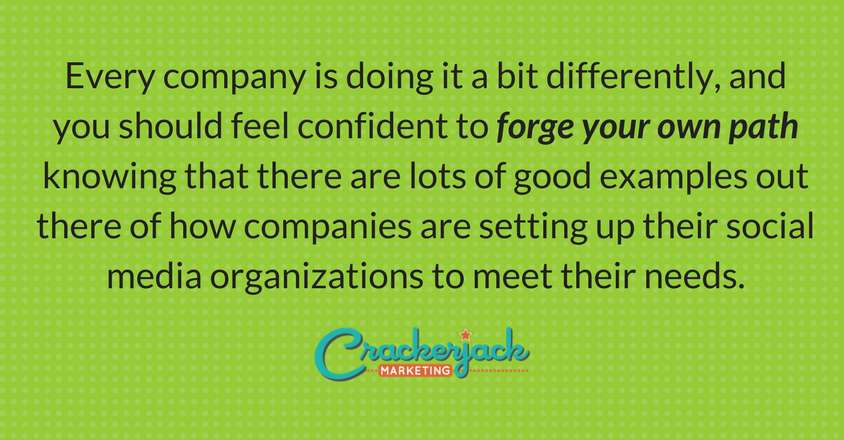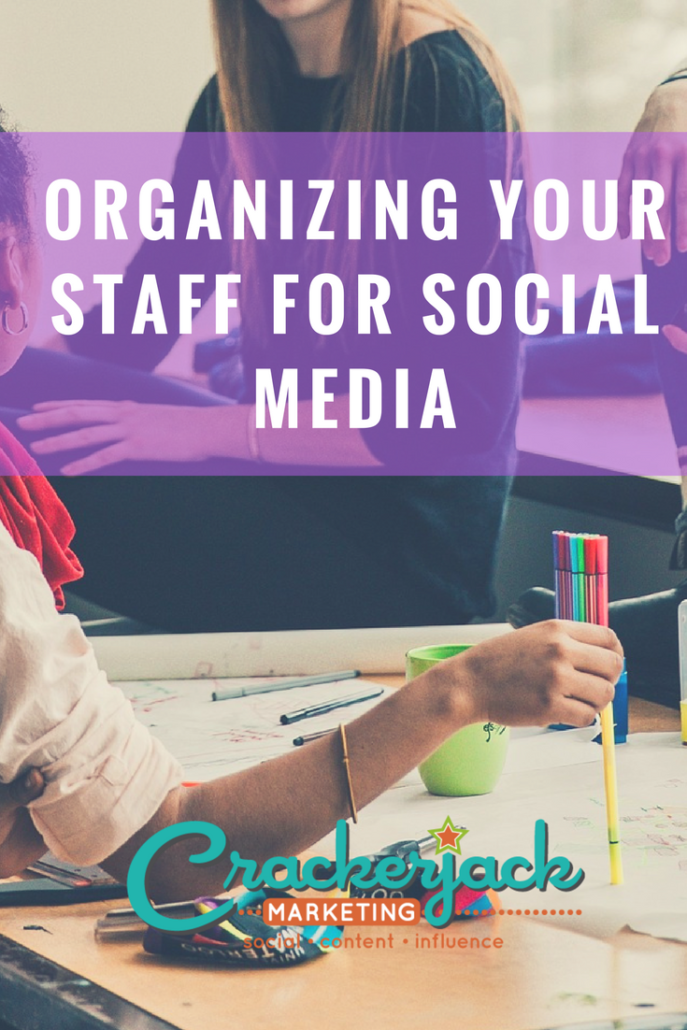Organizing Your Staff for Social Media

Just where does social media belong in an organization? Is it a marketing or public relations tool? Is it owned by customer service? Is it in a category by itself? And – is it even important to put social media in a category? The answer is yes and no. You can implement social media strategies and enjoy success without choosing a classification. But classifying it may prove critical when you are creating social media policies and planning across the organization.
Which Department Handles Social Media?
Many companies, and social media practitioners, would have social media live in either PR or marketing. And its easy to see why. Social media has been proven time and time again as an important corporate communications tool, as well as a solid marketing tool. And it’s clear that the length of social media’s arm and the receptiveness of online audiences make it an optimal tool for public relations departments. But social media is so much more. It has also become an important tool for R&D, customer service, and even employee recruitment.more
Each company may have a different strategy when it comes to deciding which department owns social media, but more and more are agreeing that it should be owned by everyone and therefore it may be classified as an organization-wide endeavor. However, when ownership of social media is spread throughout an organization, communication and collaboration are key. Various departments must work together to coordinate the use of social media tools and ensure that the organization’s goals are met and everyone is on the same page. Internal communication and collaboration is critical for avoiding brand confusion and ensuring consistent implementation of cohesive strategies that benefit the organization overall. Many companies have established “social media councils” for this very purpose, bringing stakeholders from across the organization to regular meetings and online collaboration communities to work together on the company’s social media efforts.
Another school of thought is that social media should stand on its own as its own department. When social media is used across a variety of departments, some assert that it’s better for social media experts to hold the reins, communicating and planning strategies with representatives of the organization’s other departments. Others believe it’s a better idea to gradually spread ownership out over a range of departments as long as one department holds the reins initially. In this case, a department – say public relations – may explore social media and create strategies before moving on to educate other departments on the use of social media tools.
Departmental Uses of Social Media
Let’s now look at how individual departments can use social media.
Public Relations
Have a new product or service? Have exciting plans in the works? Social media makes it easy to spread the word. Start a buzz and encourage others to help you promote your products or services. Request reviews and testimonials and make sure everyone gets to read the great things people are saying about your company. Often, people who would be utterly disinterested in yet another new site or product are eager to check it out when someone in their network recommends it.
Other PR uses of social media include using social media to find, communicate, and develop relationships with journalists and bloggers; and monitoring what key journalists and bloggers are writing about and staying informed of their current topics of interest. You can also deepen customer understanding of your company or product by producing online video and sharing it through your corporate site as well as YouTube and Facebook. Some companies are also successfully supporting their corporate cause marketing programs by using their social presences to draw attention to their supported charities or causes.
Marketing
Social media and marketing are a natural fit. Social media allows marketers to engage with audiences – providing valuable content, interaction, tools and tips which engender customer loyalty and attract new fans to the mix.
Increasingly, social media marketing is dependent on creating and curating a steady stream of quality content which becomes an entertaining or helpful resource to customers and potential customers. In order to become a trusted resource for your fans, be attentive: listen to what your market wants and then offer it. Use your own original content and curate from smart, non-competitive sources. Provide 90 percent value and 10 percent sales/company information – or go even lighter on the company info. This content mix works for Twitter, Facebook, your corporate blog or any other social platform.
Other ways marketers can socialize their efforts include announcing new products and services and giving community members the first chance to try or buy; posting special coupons or offers to fans and followers; promote marketing events through social platforms; and generating casual marketing research through polls, Twitter chats and blog comments. Business-to-business companies use whitepapers, webinars or blogs to drive leads into their pipeline, and support that content with social network engagement.
Customer Service
Many organizations now use social media as a way to manage customer service concerns. I tell clients that “Twitter is the new 800 number” – customers expect to connect to your company using whatever platform they use the most, and they don’t care if you personally don’t understand Twitter. Why? Because social media allows customers to feel connected to your organization, by giving your company a more personal face. Use social media to answer questions related to your products and services, solve customer problems, and monitor customer issues before they get out of hand. Use the feedback you obtain through social channels to enhance the customer experience, plan for the future, and revise policies.
And whether you like it or not, people discuss products and services online, both before and after they purchase them. They share the good, the bad, and the ugly; not privately, but out in the open for fellow customers and prospects to see. By being engaged and responsive, you can enhance your company’s image and build customer loyalty. And if you build your loyal social media following before the crisis breaks, they’ll be much more likely to help out when you really need them – versus trying to rally people after the fact.
Recruiting Talent
Social media tools make it easier to target talent from various geographic regions and attract tech-savvy candidates. Use social media to mount and enhance employee referral programs and to attract talent that isn’t actively visiting employment boards but is actively using social networking. Post jobs (try using Twitter hashtag #jobs) and search for talent on popular social media sites, but don’t forget the importance of personal networking using social media, too. Your former coworker might just refer you to a top-notch candidate, and they could be just a Facebook message away.
Other Departments Using Social Media
The R&D or merchandising department might want to jump on the social media bandwagon too, to listen to the conversation about products, packaging and pricing. Social might have bubbled up from your search marketing department, or maybe IT – or they could be important partners in your social media efforts. Internally-focused departments like HR or training may want to use it for social media to motivate and engage with employees.
There is no “right” way to structure or deliver on social media. Every company is doing it a bit differently, and you should feel confident to forge your own path, knowing that there are lots of good examples out there of how companies are setting up their social media organizations to meet their needs.
What’s working for you? What are you struggling with? I’d love to hear your thoughts in the comments.


She’s been in social media for over 20 years, and teaches digital marketing at universities in Barcelona and Bangkok.
Follow her on LinkedIn
for expert LinkedIn and marketing advice.
STEPHANIE SCHWAB
CEO & Founder
Stephanie is the Founder and CEO of Crackerjack Marketing.
She’s been in social media for over 20 years, and teaches digital marketing at universities in Barcelona and Bangkok.
Follow her on LinkedIn
for expert LinkedIn and marketing advice.
Categories
Organizing Your Staff for Social Media

Just where does social media belong in an organization? Is it a marketing or public relations tool? Is it owned by customer service? Is it in a category by itself? And – is it even important to put social media in a category? The answer is yes and no. You can implement social media strategies and enjoy success without choosing a classification. But classifying it may prove critical when you are creating social media policies and planning across the organization.
Which Department Handles Social Media?
Many companies, and social media practitioners, would have social media live in either PR or marketing. And its easy to see why. Social media has been proven time and time again as an important corporate communications tool, as well as a solid marketing tool. And it’s clear that the length of social media’s arm and the receptiveness of online audiences make it an optimal tool for public relations departments. But social media is so much more. It has also become an important tool for R&D, customer service, and even employee recruitment.more
Each company may have a different strategy when it comes to deciding which department owns social media, but more and more are agreeing that it should be owned by everyone and therefore it may be classified as an organization-wide endeavor. However, when ownership of social media is spread throughout an organization, communication and collaboration are key. Various departments must work together to coordinate the use of social media tools and ensure that the organization’s goals are met and everyone is on the same page. Internal communication and collaboration is critical for avoiding brand confusion and ensuring consistent implementation of cohesive strategies that benefit the organization overall. Many companies have established “social media councils” for this very purpose, bringing stakeholders from across the organization to regular meetings and online collaboration communities to work together on the company’s social media efforts.
Another school of thought is that social media should stand on its own as its own department. When social media is used across a variety of departments, some assert that it’s better for social media experts to hold the reins, communicating and planning strategies with representatives of the organization’s other departments. Others believe it’s a better idea to gradually spread ownership out over a range of departments as long as one department holds the reins initially. In this case, a department – say public relations – may explore social media and create strategies before moving on to educate other departments on the use of social media tools.
Departmental Uses of Social Media
Let’s now look at how individual departments can use social media.
Public Relations
Have a new product or service? Have exciting plans in the works? Social media makes it easy to spread the word. Start a buzz and encourage others to help you promote your products or services. Request reviews and testimonials and make sure everyone gets to read the great things people are saying about your company. Often, people who would be utterly disinterested in yet another new site or product are eager to check it out when someone in their network recommends it.
Other PR uses of social media include using social media to find, communicate, and develop relationships with journalists and bloggers; and monitoring what key journalists and bloggers are writing about and staying informed of their current topics of interest. You can also deepen customer understanding of your company or product by producing online video and sharing it through your corporate site as well as YouTube and Facebook. Some companies are also successfully supporting their corporate cause marketing programs by using their social presences to draw attention to their supported charities or causes.
Marketing
Social media and marketing are a natural fit. Social media allows marketers to engage with audiences – providing valuable content, interaction, tools and tips which engender customer loyalty and attract new fans to the mix.
Increasingly, social media marketing is dependent on creating and curating a steady stream of quality content which becomes an entertaining or helpful resource to customers and potential customers. In order to become a trusted resource for your fans, be attentive: listen to what your market wants and then offer it. Use your own original content and curate from smart, non-competitive sources. Provide 90 percent value and 10 percent sales/company information – or go even lighter on the company info. This content mix works for Twitter, Facebook, your corporate blog or any other social platform.
Other ways marketers can socialize their efforts include announcing new products and services and giving community members the first chance to try or buy; posting special coupons or offers to fans and followers; promote marketing events through social platforms; and generating casual marketing research through polls, Twitter chats and blog comments. Business-to-business companies use whitepapers, webinars or blogs to drive leads into their pipeline, and support that content with social network engagement.
Customer Service
Many organizations now use social media as a way to manage customer service concerns. I tell clients that “Twitter is the new 800 number” – customers expect to connect to your company using whatever platform they use the most, and they don’t care if you personally don’t understand Twitter. Why? Because social media allows customers to feel connected to your organization, by giving your company a more personal face. Use social media to answer questions related to your products and services, solve customer problems, and monitor customer issues before they get out of hand. Use the feedback you obtain through social channels to enhance the customer experience, plan for the future, and revise policies.
And whether you like it or not, people discuss products and services online, both before and after they purchase them. They share the good, the bad, and the ugly; not privately, but out in the open for fellow customers and prospects to see. By being engaged and responsive, you can enhance your company’s image and build customer loyalty. And if you build your loyal social media following before the crisis breaks, they’ll be much more likely to help out when you really need them – versus trying to rally people after the fact.
Recruiting Talent
Social media tools make it easier to target talent from various geographic regions and attract tech-savvy candidates. Use social media to mount and enhance employee referral programs and to attract talent that isn’t actively visiting employment boards but is actively using social networking. Post jobs (try using Twitter hashtag #jobs) and search for talent on popular social media sites, but don’t forget the importance of personal networking using social media, too. Your former coworker might just refer you to a top-notch candidate, and they could be just a Facebook message away.
Other Departments Using Social Media
The R&D or merchandising department might want to jump on the social media bandwagon too, to listen to the conversation about products, packaging and pricing. Social might have bubbled up from your search marketing department, or maybe IT – or they could be important partners in your social media efforts. Internally-focused departments like HR or training may want to use it for social media to motivate and engage with employees.
There is no “right” way to structure or deliver on social media. Every company is doing it a bit differently, and you should feel confident to forge your own path, knowing that there are lots of good examples out there of how companies are setting up their social media organizations to meet their needs.
What’s working for you? What are you struggling with? I’d love to hear your thoughts in the comments.


Search our Blog
Get our Free Editorial Calendar Template.
Are you stressed out by the time it takes to create great content?
In this handy Google Doc, which you can save and use on your own, you’ll get a super-simple layout to guide your content creation and management efforts.
DOWNLOAD TODAY
STEPHANIE SCHWAB
CEO & Founder
Stephanie founder and CEO of Crackerjack Marketing.
She’s been in social media for over 20 years, and teaches digital marketing at universities in Barcelona and Bangkok.
Follow her on LinkedIn
for expert LinkedIn and marketing advice.
Create your own spark
Join 5,000+ marketers who receive our B2B marketing ideas and insights each week.
Join 5,000+ marketers who receive our B2B marketing ideas and insights each week.
Who We Serve
Company
Who We Are
Our Services
Blog
Free Editorial Calendar Template
Work With Us
Resources
Chicago, Barcelona, Mumbai
1055 W. Bryn Mawr Suite F-196
Chicago, IL 60660
+1-312-429-5588
Headquarters:
© Copyright 2025 Kyle Partners, LLC, d/b/a Crackerjack Marketing. All rights reserved. | Terms of Service | Privacy Policy